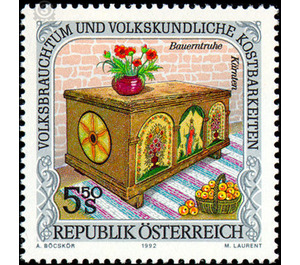folklore - Austria / II. Republic of Austria 1992 - 5.50 Shilling
Theme: Art & Culture
| Country | Austria / II. Republic of Austria |
| Issue Date | 1992 |
| Face Value | 5.50 |
| Color | multi-colored grey |
| Printing Type | combination printing |
| Stamp Type | Commemorative |
| Item Type | Stamp |
| Chronological Issue Number | 1417 |
| Chronological Chapter | OOS-OE2 |
| SID | 197092 |
| In 64 Wishlists | |
Carinthian rustic furniture shows not only regional but also features of their gradual 400-year development. The country cottage was once the most important furnishing and wedding furniture and at the same time a status symbol of the population. The illustrated chest, today admired in the furniture section of the Carinthian open-air museum, was acquired in 1974 in the village of Trieblach in the Lower Rosental. The so-called chest chest, made from softwood in a galvanized construction, stands on low, square blocks. In its basic elements it still appears as the echo of the carpentry art of rural furniture, which flourished in Carinthia, especially in the Renaissance, in the 17th century. Differently the painted decoration, which corresponds to the Nachbiedermeier around 1850.


